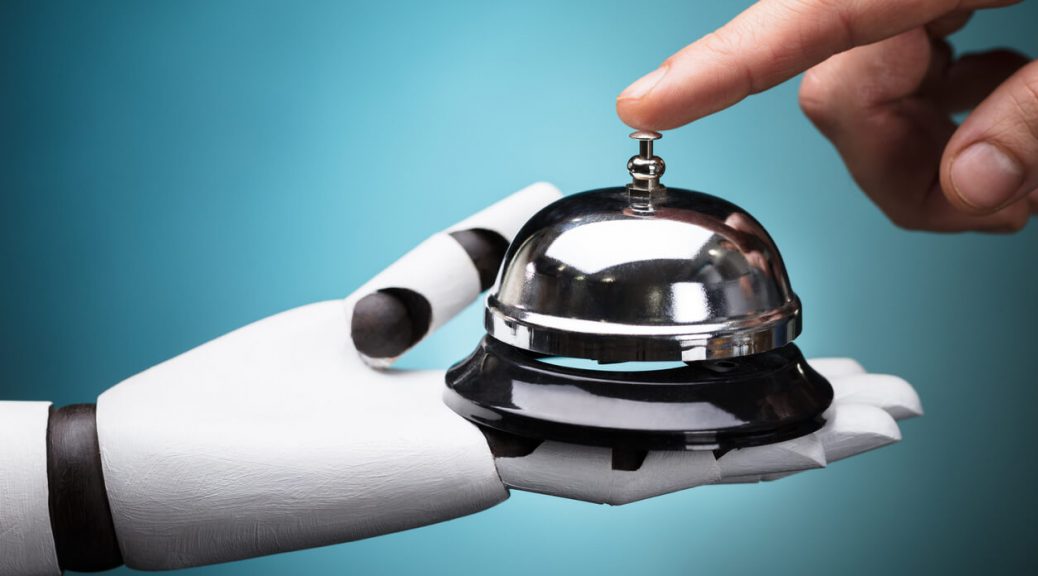
6 New Restaurant Technology Trends for 2021
We’ve still got a way to go before restaurant technology reaches the point where meals are 3D printed to order (imagine that!), but that doesn’t mean the technology used in the restaurant business today isn’t already changing the industry. Indeed, restaurant technology trends are sweeping the country from coast-to-coast and revolutionizing the restaurant experience for us all.
Get your aprons on, because we’re about to dig into the top 6 ways that business owners are incorporating technology in restaurants.
These are the 6 top restaurant technology trends in 2021.
1. Digitized Point of Sale (POS) systems for increased efficiency
POS, or point of sale, is the time and place where the financial transaction is made at a business. Up until recently, the restaurant POS systems were old-fashioned cash registers. Today, one of the most important pieces of technology in the restaurant industry is the digital restaurant POS system.
Modern point of sale systems have multiple benefits, including:
- Flexibility with the types of payments they accept (Apple Pay, Venmo, etc.)
- Data feedback which allows business owners to optimize their inventory purchasing patterns, marketing strategies, and so on
- Speeding up checkout by allowing customers to pay at their convenience on their mobile phone
- Retention of both customers and employees by providing appealing, up-to-date services that improve the customer experience and reduce stress for employees
2. Using automated in-house digital ordering software
You may be familiar with seeing in-house digital ordering systems in fast food chains like McDonald’s. In case you aren’t a fast food fan, in-house digital ordering typically comes in the form of big touch screens or even tablets that allow a customer to order for themselves and even make a payment without ever having interacted with an employee. What are the main perks of this restaurant technology?
Advantages of in-house digital ordering systems:
- Eliminate human error
- Upsell the money-making items
- Improve menu options by using data about ordering patterns
- Optimize customer-employee interactions by using insights from data
3. Offering free WiFi for restaurant customers
This point is pretty self-explanatory. If you don’t have internet access in your restaurant, it will raise a lot of eyebrows (and drive away a certain percentage of customers). We live in the era of smartphones, and people can find any excuse to keep these handheld computers in, well, their hands! That being the case, it’s in your business’s best interest to give potential customers every reason to eat at your establishment and not at your competitors’. This may seem like a no-brainer, but it’s worth the reminder since so many other restaurant technologies will ultimately depend on the availability of a strong and reliable internet connection.
Perks of providing WiFi in your restaurant:
- Attract customers who continue working remotely while they’re eating
- Keep existing customers at your business for longer, thus raising the chances of them ordering more food or drinks
- Maintain a reputation for being modern and up-to-date
- Connect your systems and keep internal operations speedy

4. Creating a mobile App to improve customer engagement
Mobile applications for smartphones have got to be one of the best ways to incorporate restaurant software into your business practices. More than one-third of the world’s population uses smartphones – that’s more than 2 billion hungry mouths! Additionally, there are more than 180 billion mobile app downloads to date, and that number continues to grow. Clearly, people like their smartphones and they like using apps (the average smartphone user uses nearly 40 apps every month).
How does that relate to using technology in the restaurant industry? For one thing, 40% of 18 to 34-year-olds prefer to pay for their restaurant orders via their mobile phone. And with the number of restaurants that have a mobile app at just 16%, there’s plenty of room for you to make good use of this type of restaurant technology.
How you can use a mobile app for your restaurant:
- Gain awareness by using location services to alert potential customers when they’re near your restaurant
- Offer loyalty programs that give customers special deals on holidays or rewards for frequent visitors
- Optimize the online ordering process by allowing customers to submit their requests anywhere and anytime
- Provide customers with the ability to make remote reservations
- Synchronize with social media accounts (more on that below)
5. Using social media to communicate with customers
The world of social media has totally reshaped the way that businesses communicate with their customers. By this time it may not be considered a ‘new’ form of technology, but nonetheless, there are particular advantages that social media presents for small businesses in competition with their big corporate counterparts. Besides providing the ability to develop a modern social media marketing strategy for businesses, social media has a number of other impacts on the restaurant industry.
Top ways that social media impacts the restaurant industry:
- Puts a ‘face’ to the name and allows restaurant owners to develop the business’s ‘personality’
- Makes advertising affordable for small businesses
- Provides an open line of communication for customers to communicate directly with the restaurant
6. Installing IoT software to enhance equipment safety and performance
Big data and the Internet of Things are two terms that are echoing throughout many different industries, including trucking, construction, manufacturing, and more. As with so many industries, when it comes to technology in restaurants, the machines that make the biggest difference aren’t digital. The most fundamental pieces of restaurant equipment are bulky items, such as walk-in refrigerators, deep-freezers, flat grills, deep-fryers, ovens, industrial mixers, and so on. But, restaurant software still can make a big difference in keeping those crucial components in working order.
By using simple and easy-to-install IoT sensors to kitchen equipment, restaurants can use the data that’s collected to:
- Measure temperature in a refrigerator or heating station
- Maintain proper equipment performance by making small fixes before bigger repairs are needed
- Monitor whether equipment is meeting regulatory standards
How to finance new restaurant technology
Regarding the cost of keeping up with restaurant technology trends, not every type of restaurant software or restaurant technology will be easily affordable. Fortunately, there are options for restaurant owners to pick from if and when they’re in need of a financial boost.
Of course, the type of business will affect the kind of industry loans a business needs, as well as the specific circumstances that business finds itself in. Be sure to weigh your options carefully in order to choose the right funding solution for your business.
Become uses advanced algorithms to simplify the application process and improve the approval odds for businesses applying for financing. Additionally, the patented LendingScore™ technology assesses a business’s financial profile and then provides tailored guidance on which specific funding factors are keeping a business from accessing more and better funding options.
Restaurant loans to help finance new technology:
Unsecured business loan
For business owners that have relatively higher credit scores, unsecured small business loans offer some of the best terms available. The ‘unsecured’ part of ‘unsecured business loans’ means there’s no need to provide valuable assets as collateral. That means the loan provider takes on a bigger risk than the restaurant. It also means that purchasing restaurant technology doesn’t require putting existing assets in jeopardy of being repossessed.
Qualifications & Features
- Minimum time in business: 6 months
- Minimum monthly revenue: $5,000
- Minimum credit score: 350 (FICO)
Line of credit
While a business line of credit is typically recommended as a backup form of business financing, it can also be used for purchasing technology in the restaurant industry. The most important part of using a business line of credit is to do so responsibly and not to get confused between good debt and bad debt. Business lines of credit are flexible, allowing restaurant owners to use them for restaurant software or restaurant technology that falls under the hardware category.
Qualifications & Features
- Minimum time in business: 3 months
- Minimum monthly revenue: $5,000
- Minimum credit score: 300 (FICO)
Equipment financing
Not every type of restaurant technology falls under the category of ‘restaurant software’ – some of it comes in physical form as well. For those pieces of hardware, restaurant equipment financing is one of the most common ways that business owners are able to cover the costs of technology used in restaurant business. And thanks to the way that fintech has revolutionized the business lending process, it’s easier than ever to get matched with the right lender.
Qualifications & Features
- Minimum time in business: 3 months
- Minimum monthly revenue: $5,000
- Minimum credit score: 450 (FICO)
Final course
At the current pace of technological innovation, the restaurant technology trends listed here may be spoiled within a few months’ time. So, be sure to check for new ways that technology is used in the restaurant business on a regular basis. Ultimately, the goal of using technology in a restaurant is to improve the way the business operates in an effort to improve the business’s profitability. Hopefully, the information provided here helps to make that a reality for your restaurant! Please feel free to share this article on social media and with any of your fellow restaurateurs.


 Please wait...
Please wait...




